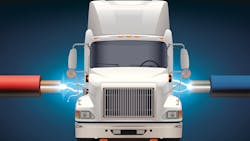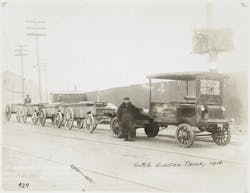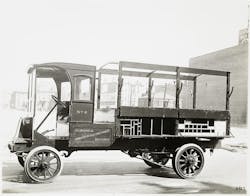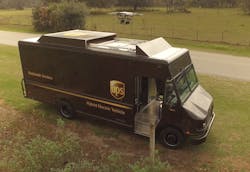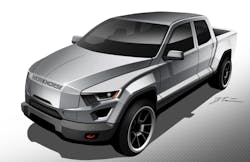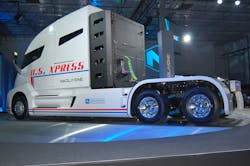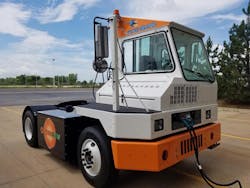Electric vehicles in trucking: Offering benefits then and now
Electric power in trucks and trucking: it’s such a neo-modern, 2000s and 2010s kind of concept. Isn’t it? Or maybe, actually, it’s something much older, stretching back to the turn of the 20th century and the very earliest days of commercial and passenger automobiles. What might surprise some advocates and others interested in electric trucks is how closely what was said about them more than a century ago mirrors what’s being said still today.
The earliest internal combustion engines had to be cranked, weren’t particularly reliable, weren’t particularly powerful, and could often be noisy and dirty. Meanwhile, in the early 1900s, homes were still being electrically wired; electricity brought and was full of new possibility. Large battery technology—as in batteries used in applications like vehicles—was expensive, but respectably capable.
An October 1915 article in the New York Times noted that “the largest transportation delivery fleets in the world are chiefly composed of electric vehicles.” Businesses like department stores, bakeries, breweries and laundry service providers all, in various percentages, had been purchasing and using electric trucks going back to the turn of the century as the first automobiles trickled into society.
The article, “Electric Proves Value in Laundry Service,” profiled Henry Sieminski of Jersey City, NJ, and his laundry business. The company had replaced a number of horses and wagons used in city laundry service pickups and deliveries with eighteen 1,000-lb. electric delivery trucks, running them successfully for three years. “The 18 electrics have not only done the work of the 40 horses which I formerly owned, but also take care of an unusually heavy increase in business,” Sieminski stated.
The laundry burned coal in generating its own electricity, which it used to heat large amounts of water used for industrial-load washing. Sieminski said he considered it a “by-product” to charge the electric trucks at night as well, since the company had to use much more electricity in heating water anyway. He also considered it a by-product that the company got distilled water it used in the trucks’ batteries from steam that collected above the company’s hot laundry tanks.
Sieminski pointed out a number of advantages of the electric trucks for his business, including very low cost. He figured that the electricity needed to charge the trucks cost $71/month, or $4 per vehicle per month (and with the distance each truck covered, it worked out to about six-tenths of a cent per mile to charge and run the vehicles). Maintenance of the electric trucks was “negligible,” Sieminski said, and didn’t amount to much, and what parts were on the trucks were standard and easy enough to get and replace, even if a manufacturer went out of business.
While tires on the laundry business’s gasoline trucks would last 3-4 months, tires on the electric trucks lasted much longer at 1.5-2 years, and the electric vehicles themselves would last perhaps 15 years or more, since they had little need for maintenance and few parts generally. Electrics got a “legendary” reputation for working almost indefinitely, and there seemed also to be a matter of them getting better traction in inclement weather.
“During the most severe snowstorms last winter, our electrics made their usual number of trips in the same average time. Several times our gas cars were stalled and had to be towed in,” said Sieminski. That was backed up seven years later in the Edison Monthly published by the New York Edison Co.: “Ice on the asphalt has no terrors for electric trucks. Their traction is sure and their control is positive, and they can pick their way in and out of traffic without the least inconvenience.”
Relics of the past or ahead of their time?
The other benefit, in a very noticeable way, was image. Sieminski stated in the Times that he felt that having the electric trucks hauling through the streets of Jersey City boosted his company’s appearance out among the public. “A clean, attractively painted, smooth-running, silent electric is the best advertiser in the world for the laundry business,” he contended. “I am fully convinced that for laundry delivery service, the electric is the most efficient and economic vehicle.”
In May 1922, the Edison Monthly reported that “the future of the electric vehicle is assured because good transportation is based on economy and reliability—and the electric has both.” Speakers at an electric vehicle convention the prior month in New York had “showed beyond question that in their proper fields, electrics far outclass any other type of delivery equipment.”
Into the 1920s, 1930s and beyond, businesses making various kinds of deliveries—including United Parcel Service— ran electric trucks, well after electric vehicles had been eclipsed by gasoline- and diesel-powered ones, particularly in the commercial vehicle arena. But at long last, electric trucks faded into memory and were relegated to more and more obscure use, and the decades marched on.
Hurricane of the present
And suddenly, we’ve arrived at the present alternative fuels use in trucking in 2017, and electric trucks seem to have wrestled a spotlight all to themselves. For the past several years as gas and diesel prices have been very low in the United States, natural gas used in trucking—most often compressed natural gas, but also liquid natural gas—has been sidelined somewhat. At the same time, though, last year and this year have somehow continued to bring quite a flurry of news about electric trucks.
Part of the evidence of a surge in electric vehicles is the growing noise coming from the competition. Reuters reported on Feb. 21, for example, of a U.S. biofuels lobbying group joining forces with an oil industry group, though they’d been longtime rivals, “noting electric vehicles as one area where both sides have concerns.” That concern in particular was about government subsidies for electric vehicles and other vehicle types losing ground.
What’s notable with electric power in trucking is how widespread the news has been. There’s been activity from heavy Class 8 electric yard trucks and waste trucks to medium-duty delivery vehicles—a particularly promising use—with some light- and medium-duty electrics used for last-mile delivery operations. But there’ve also been light- and heavy-duty electric trucks released by Daimler and a dramatic-looking heavy-duty electric truck from Nikola among new electric trucks bursting onto the scene.
A study by the Consumer Federation of America (CFA) in September last year found that consumer interest and acceptance of electric vehicles is growing. When asked if that increasing consumer familiarity with EVs might help drive EVs in trucking, a CFA representative told Fleet Owner it’s more likely to be the other way around: that EVs in trucking will help drive consumer use and adoption of EVs in the passenger car world. And meanwhile, a January report from Navigant Research estimates global sales of electric medium- and heavy-duty trucks will reach a significant 332,000 in 2026.
Workhorse
In the medium-duty segment, Workhorse Group Inc. has built up some steam over the last year or so with improvements, sales and new technology demonstrations with its hybrid electric trucks. The company’s E-GEN delivery truck got a smaller, more fuel-efficient BMW gasoline engine that comes on to charge the batteries and extend the truck’s range when charge is drained.
Further, however, Workhorse also builds drones. UPS, which announced purchases of 325 of Workhorse’s delivery trucks, also in February this year showcased its testing of a Workhorse truck and HorseFly octocopter drone. The drone can supplement a driver and/or other workers delivering packages up to 10 lbs. on delivery flights up to half an hour long.
“It has implications for future deliveries, especially in rural locations where our package cars often have to travel miles to make a single delivery,” said Mark Wallace, senior vice president of global engineering and sustainability at UPS. “Imagine a triangular delivery route where the stops are miles apart by road; sending a drone from a package car to make just one of those deliveries can reduce costly miles driven.”
Workhorse has been blazing some new trails in medium-duty vehicles in terms of fuel efficiency. The company drew from telematics data that its trucks generate to calculate that the E-GEN is achieving the equivalent of 30-plus mpg during stop-and-go parcel, bakery and uniform delivery routes. The vehicles, Workhorse claims, can offer a saving of as much as $165,000 in total cost of ownership vs. gasoline or diesel trucks.
A final but significant note for Workhorse is the company’s forthcoming W-15 electric pickup, which right now can be seen only via a few dramatic-looking sketches. Workhorse says it will feature plenty of advanced safety technology and was designed to be “the safest pickup ever built,” offering 4WD, 2,200-lb. payload, 5,000-lb. towing capability, 80-mi. battery-only range, and unlimited extended range via its BMW gas-powered generator motor.
With an order for 500 of the W-15 electric pickups just in from Clean Fuels Ohio, Workhorse says it also has commitments from Duke Energy, Portland General Electric, the City of Orlando (FL), and Southern California Public Power Authority for the trucks.
Nikola
Possibly the biggest splash to have hit the news lately regarding electric trucks was made by the Nikola One hydrogen-electric Class 8 tractor officially unveiled in December. This thing uses high-density lithium batteries and generates additional energy via hydrogen fuel cell; Nikola Motor Co. says the truck will have a range between 800 and 1,200 mi.
Very notably also, the Nikola One’s electric drive system is expected to deliver a massive 1,000 hp. and 2,000 lbs.-ft. of torque. Because all that power and torque is available from the electric drive system immediately, the truck is estimated to take off and blow through a 0-60 mph run in 30 sec., which means it’s twice as fast off the line as a conventional diesel heavy truck, Nikola estimates.
One of the first customers to step up and say it’s ordering the Nikola One was U.S. Xpress Enterprises Inc., which said it plans to add an unspecified number of the tractors to its fleet when they go into production in 2020. “U.S. Xpress drivers are going to have one of the most environmentally sound trucks on the road that they are going to love to drive,” said Nikola Motor CEO Trevor Milton.
“America is looking for a change,” Milton wrote in a column for Fleet Owner. “Zero tailpipe emissions from commercial trucks is incredibly important. America is tired of loud, dirty and smelly diesel trucks polluting our environment.” He contends Nikola has orders for more than 8,000 of the hydrogen-electric tractors and plans to construct over 360 hydrogen stations nationwide.
“As diesel fleets are retired, America’s operators will be able to turn to hydrogen and electricity to power their trucks,” Milton predicts, if overly optimistically. “Diesel engines will always have a place in America, but they will suffer a slow, painful death similar to what Kodak experienced with its film business with the debut of digital cameras.”
Daimler / Mercedes-Benz
At IAA 2016 in Hannover, Germany, the world’s largest commercial vehicle show, Daimler’s truck group showed off the Mercedes-Benz Urban eTruck, a fully electric cabover with refrigerated body and 26-ton GVW. The futuristically sleek, somewhat narrow-profiled truck appears designed to navigate through the tightest European roadways.
“We are currently talking to around 20 potential customers from the disposal, foodstuffs and logistics sector,” noted Stefan Buchner, head of Mercedes-Benz Trucks worldwide, of the Urban eTruck’s future sales potential. As he continued, the pitch carried elements electric truck proponents claimed over a century ago: “Zero emissions, quiet as a whisper and with a payload of 12.9 ton, the Urban eTruck offers an impressive, economical and environmentally friendly concept.”
Dipping its toe ever so slightly into the water, Daimler says it will deliver the first handfuls of Urban eTrucks this year. “The vehicle will initially go in a low two-figure number of units to customers in Germany, and later in Europe, too,” Buchner stated. “It will be used in real transportation applications there.”
Daimler also offered up the Mercedes-Benz Vision van, an electrically powered, zero-emission, almost liquid-sculpted work van. It’s a last-mile-type delivery van and can carry one or more drones capable of helping deliver packages, just as others are looking to test and implement.
In the light-to-medium sweet spot, the Class 4 Mitsubishi Fuso eCanter all-electric truck is coming to the U.S. market this year. Rather counter to what we’re seeing in EVs from Daimler, Wolfgang Bernhard, formerly the head of Daimler Trucks, noted recently that a decade ago, he saw “no market” for electric trucks.
However, battery technology advanced about 2.5-fold and costs went down by roughly that same factor since then. And that brings us to this year, when the Fuso eCanter will simultaneously arrive in “small-scale production” numbers in the United States, Japan and Germany and is likely to find itself in a range of urban delivery scenarios.
Orange EV big yard trucks
Late last summer, Orange EV announced it’s accepting orders for its Class 8 T-Series electric terminal truck, a.k.a. yard mule, hostler or spotter truck. The trucks, which can carry a price tag in the mid-to-high $200,000s each, also are eligible for big discounts courtesy of California’s Hybrid and Zero-Emission Truck and Bus Voucher Incentive Project.
Incentive funds can reduce the cost per T-Series truck by up to $140,000, resulting in a net cost as low as $105,000 per truck. That enables fleets “to purchase electric trucks with the same funds earmarked for diesels, and then operate for significantly less, saving up to 90% net in fuel and more in a broad range of other areas,” according to Mike Saxton, chief commercial officer at Orange EV.
Saxton spoke with Fleet Owner about why fleets consider switching to the electric yard mules. He said it was about “getting the job done while eliminating diesel fuel and emissions.” Using incentives such as those noted above, fleets can minimize equipment costs of electric trucks and then save considerably in the long run. Saxton explained that compared with fuel costs for diesel yard trucks and accounting for the costs to recharge the Orange EV trucks, purchasers can expect to save a net of 80-90%.
Also, much of the mechanical systems on diesel trucks—things like engine, transmission and emission/exhaust systems—are replaced by batteries and a maintenance-free, brushless induction motor. That reduces maintenance costs for electric trucks to a relative minimum compared with diesel truck maintenance, Saxton said. In the longer term, fleets that invest in electric trucks like the T-Series yard mules can expect typical electric vehicle durability and very low operating costs.
Electric refuse trucks
The municipal waste truck sector is another that’s had some attention paid to it by electrification. It makes sense: if, for point of argument, range remains a big challenge for electric trucks and must be overcome in the case of products like the Nikola One over-the-road semi-truck, shorter local delivery routes have been a natural fit for electric trucks back since Sieminski’s Jersey City laundry business and others ran them in the early 1900s.
And along with a pickup-and-delivery-type business like a uniform service, for instance, there’s also that omnipresent municipal pickup service: waste and recyclables collection. Clipping door-to-door often in the early hours of the morning, could a clean, whisper-quiet, electric waste truck going about its business offer city residents any appeal?
Mack Trucks thinks so, and showed off one of its Class 8 LR model refuse trucks outfitted with an electric driveline last summer. The electric driveline was supplied by Wrightspeed, whose Route 1000 powertrain uses electricity for 100% of vehicle propulsion and adds a multi-fuel-capable turbine regenerator engine that can recharge the batteries and provide “unlimited” range. Wrightspeed says the heavy-duty electric drivetrain is suited for refuse, delivery and mass transit applications.
Finally, BYD and Wayne Engineering last fall announced an all-electric refuse truck that skirts that longtime EV issue of range: it’s said to cover 100 mi. per charge, and with quick-charge capability at that. It’s designed to offer wraparound visibility to assist in negotiating tight urban roads and alleyways. And Stella Li, president of BYD America, hearkened to those age-old benefits of electrics—that they’re much cleaner and environmentally friendly—in highlighting benefits of the new electric refuse truck.
“This new 3.9-ton truck, which gets 100 mi. of charge in just 2.5 hours, is the chance to finally make cleaning our neighborhoods a clean prospect in and of itself,” Li said.
About the Author
Aaron Marsh
Aaron Marsh is a former senior editor of FleetOwner, who wrote for the publication from 2015 to 2019.
